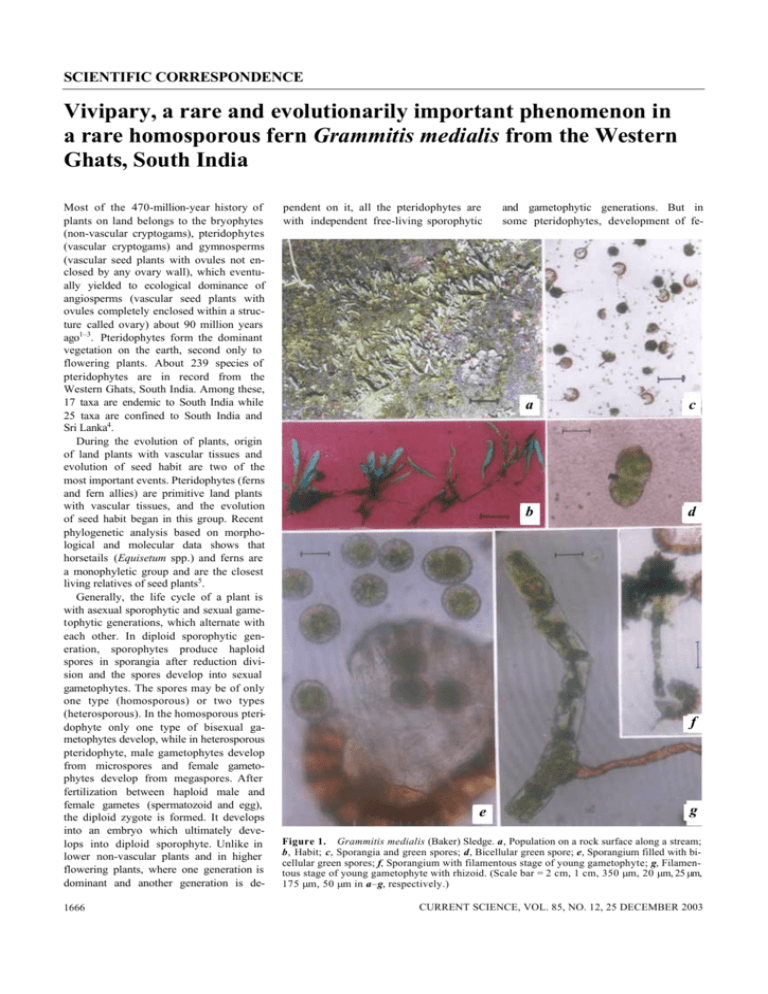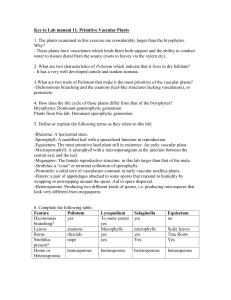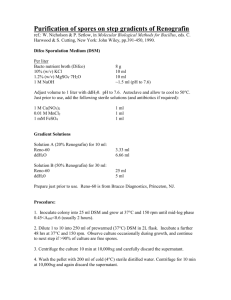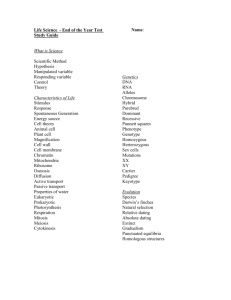Vivipary, a rare and evolutionarily important phenomenon in a rare
advertisement

SCIENTIFIC CORRESPONDENCE Vivipary, a rare and evolutionarily important phenomenon in a rare homosporous fern Grammitis medialis from the Western Ghats, South India Most of the 470-million-year history of plants on land belongs to the bryophytes (non-vascular cryptogams), pteridophytes (vascular cryptogams) and gymnosperms (vascular seed plants with ovules not enclosed by any ovary wall), which eventually yielded to ecological dominance of angiosperms (vascular seed plants with ovules completely enclosed within a structure called ovary) about 90 million years ago1–3. Pteridophytes form the dominant vegetation on the earth, second only to flowering plants. About 239 species of pteridophytes are in record from the Western Ghats, South India. Among these, 17 taxa are endemic to South India while 25 taxa are confined to South India and Sri Lanka4. During the evolution of plants, origin of land plants with vascular tissues and evolution of seed habit are two of the most important events. Pteridophytes (ferns and fern allies) are primitive land plants with vascular tissues, and the evolution of seed habit began in this group. Recent phylogenetic analysis based on morphological and molecular data shows that horsetails (Equisetum spp.) and ferns are a monophyletic group and are the closest living relatives of seed plants5. Generally, the life cycle of a plant is with asexual sporophytic and sexual gametophytic generations, which alternate with each other. In diploid sporophytic generation, sporophytes produce haploid spores in sporangia after reduction division and the spores develop into sexual gametophytes. The spores may be of only one type (homosporous) or two types (heterosporous). In the homosporous pteridophyte only one type of bisexual gametophytes develop, while in heterosporous pteridophyte, male gametophytes develop from microspores and female gametophytes develop from megaspores. After fertilization between haploid male and female gametes (spermatozoid and egg), the diploid zygote is formed. It develops into an embryo which ultimately develops into diploid sporophyte. Unlike in lower non-vascular plants and in higher flowering plants, where one generation is dominant and another generation is de1666 pendent on it, all the pteridophytes are with independent free-living sporophytic and gametophytic generations. But in some pteridophytes, development of fe- a c b d f e g Figure 1. Grammitis medialis (Baker) Sledge. a, Population on a rock surface along a stream; b, Habit; c, Sporangia and green spores; d, Bicellular green spore; e, Sporangium filled with bicellular green spores; f, Sporangium with filamentous stage of young gametophyte; g, Filamentous stage of young gametophyte with rhizoid. (Scale bar = 2 cm, 1 cm, 350 µm, 20 µm, 25 µm, 175 µm, 50 µm in a–g, respectively.) CURRENT SCIENCE, VOL. 85, NO. 12, 25 DECEMBER 2003 SCIENTIFIC CORRESPONDENCE male gametophytes and fertilization take place inside the sporangium, on the mother plant itself. Such a phenomenon is referred to as vivipary, which is considered as an important step in the evolution of seed habit in vascular plants. Evolution of heterospory and the retaining of megaspore inside the megasporangium till the formation of embryo, are the important phases in the evolution of seed habit. The condition of heterospory in the genus Selaginella constitutes one of the most important phases in the evolution of plants. In certain species of Selaginella, only one megaspore develops within the megasporangium. The most evolved species S. apoda has advanced seed habit almost to the rank of a seed plant. Here, the megaspore remains within the sporangium, germinates and develops into the gametophyte; it is fertilized and the gametophyte of Selaginella shows complete dependence of the gametophyte upon the sporophyte, as in angiosperms6. The germination of spores of these pteridophytes within the sporangium without any dormancy period, a feature seen in angiosperms, is called vivipary; it is very rare in homosporous pteridophytes. The viability period of chlorophyllous spores is usually very short6–8 and in many cases vivipary is seen. This evolutionarily important and rare phenomenon was observed in a rare and endangered homosporous fern, Grammitis medialis (Baker) Sledge from the Western Ghats, South India, as reported here. When we were looking for reasons for the rare occurrence of the fern G. medialis and to evolve conservation strategies, we examined spores of this species (voucher preserved at St. Xavier’s College Herbarium, Palayamkottai) collected from Kothayar Hills, Kakachi stream, 1000 m (Figure 1 a and b) for the presence of any abortive spores, a common reason for the rarity of many ferns. To our pleasant surprise we found that the spores are greenish and apparently normal, without visible indication of any abortion. Each sporangium was filled with 64 normal spores (Figure 1 c and e). Many of these spores were in the bicellular stage within these sporangia (Figure 1 d). In some cases, a multicellular filamentous stage with a rhizoid (Figure 1 f and g), as a result of spore germination, was also present. It is evident that spore dispersal may occur after the germination of spores in this species, as in the case of Cyathea arborea9. A thorough population study of this species will perhaps yield more information. No doubt, the delicate germinating spores help in establishment of the species in nature, but the short viability period is the main reason for the rarity of this species. This situation is a hindrance for the distribution of spores through air. When compared with dry, mature and ungerminated spores, the germinated spores cannot disperse a long distance and will be shed in the same microhabitat, as is evident from our field studies. We observed a population in 1984, on the surface of a huge rock along a shaded stream on Kothayar Hills. The same population remains as such even today, without dispersing into other microhabitats of the same stream or any adjacent stream. G. medialis is a rare fern confined to South India and Sri Lanka. It has been reported only from Kothayar Hills and Ponmudi Hills of the Western Ghats, South India. Even in these localities, the population is low. This species faces difficulties for dispersal. Conventional in vitro culture method could be adopted for propagation of the species after the sporangia are punctured to liberate the germinating spores. The germination of spores within the sporangium without complete development of gametophyte in the sporangium is a problem in the spore dispersal mechanism, which results in the rarity of this simple-leaved advanced fern. In the threat-value analysis of South Indian ferns10, following the modified method of Perring and Farrell11, G. attenuata was found to be the species with maximum threat value of 15 out of 25. It has also been concluded that ploidal level (diploid or polyploid), type of rhizome (erect or creeping), habitat (epiphyte or terrestrial) and type of spores (chlorophyllous or achlorophyllous) are the key characters which determine the rarity of a fern. The diploid, epilithic G. medialis with erect rhizome and chlorophyllous spores represents the typical rare fern. From the present observation, it is suggested that without knowing the reason for the rarity of a particular plant, the efforts taken to conserve such rare species may sometimes fail. Efforts are being made by us to multiply and conserve this rare and endangered species through spores or tissue-culture following a different protocol. CURRENT SCIENCE, VOL. 85, NO. 12, 25 DECEMBER 2003 1. Kenrick, P. and Crane, P. R., The Origin and Early Diversification of Land Plants: A Cladistic Study, Smithsonian Institution Press, Washington DC, 1997. 2. Kenrick, P. and Crane, P. R., Nature, 1997, 389, 33–39. 3. Lupia, P., Lidgard, S. and Crane, P. R., Paleobiology, 1999, 25, 305–340. 4. Manickam, V. S. and Irudayaraj, V., Pteridophyte Flora of the Western Ghats, South India, B I Publication Pvt Ltd, New Delhi, 1992. 5. Pryer, K. M., Schneider, H., Smith, A. R., Cranfill, R., Wolf, P. G., Hunt, J. S. and Sipes, S. D., Nature, 2001, 409, 618–621. 6. Pandey, B. P., College Botany: Pteridophyta, Gymnosperms and Palaeobotany, S. Chand & Company Ltd, New Delhi, 2003, vol. II. 7. Irudayaraj, V., PARAG, 1, 4. 8. Lloyd, R. M. and Klekowski, E .J., Biotropica, 1970, 2, 129–137. 9. Bir, S. S., Indian Fern J., 1995, 12, ix– xii. 10. Irudayaraj, V., Paper presented at the International Conference on Conservation of Tropical Species, Communities and Ecosystems. Tropical Botanic Garden and Research Institute, Thiruvananthapuram, 2–6 December 1998, Abstr. p. 74. 11. Perring, F. H. and Farrell, L., British Red Data Books: 1 Vascular Plants, SPNC, Nettleham, Lincoln, 1977. ACKNOWLEDGEMENTS. We thank the Ministry of Environment and Forests and the Department of Science and Technology for financial assistance. We also thank Rev Dr A. Antonysamy S. J., Principal, St. Xavier’s College (Autonomous), Palayamkottai for encouragement. Thanks are also due to the anonymous referees for help in the improvement of the manuscript. Received 17 May 2003; revised accepted 25 September 2003 V. IRUDAYARAJ V. S. MANICKAM* M. J OHNSON Centre for Biodiversity and Biotechnology, PG and Research Department of Botany, St. Xavier’s College (Autonomous), Palayamkottai 627 002, India *For correspondence. e-mail: tvl_cbbsxc@sancharnet.in 1667








